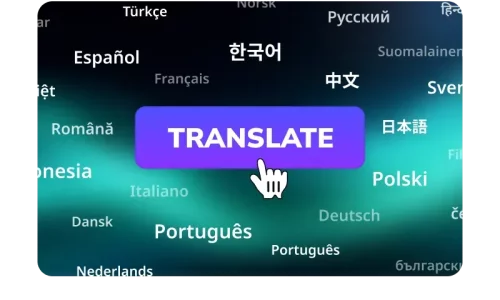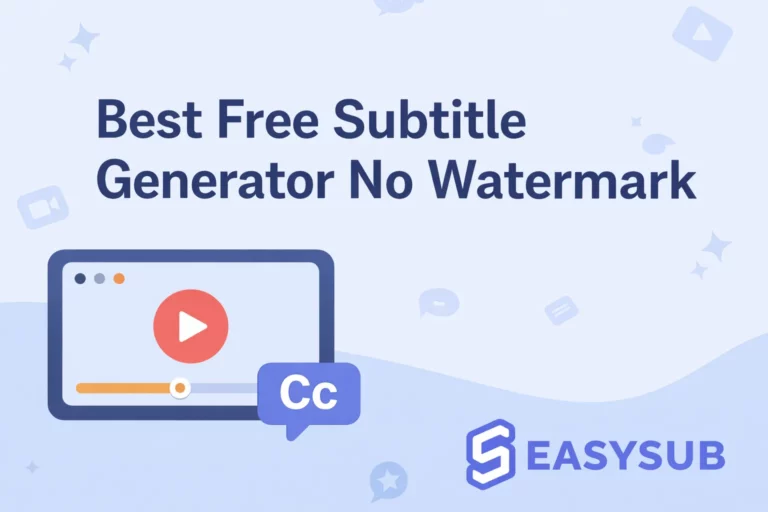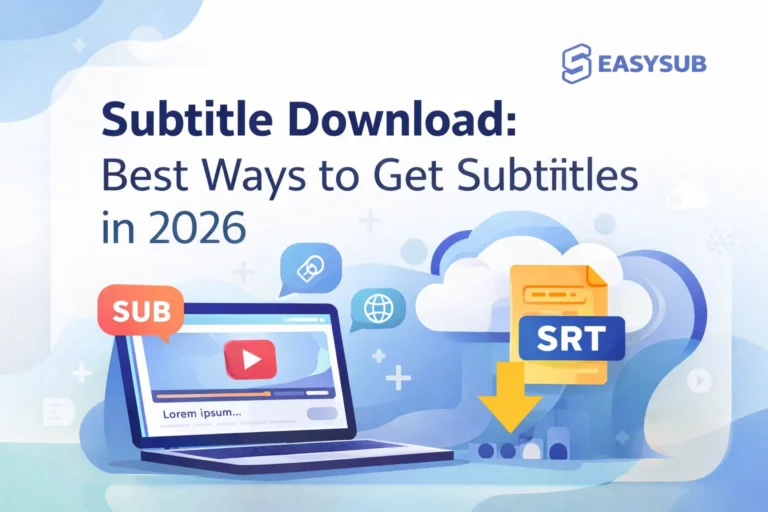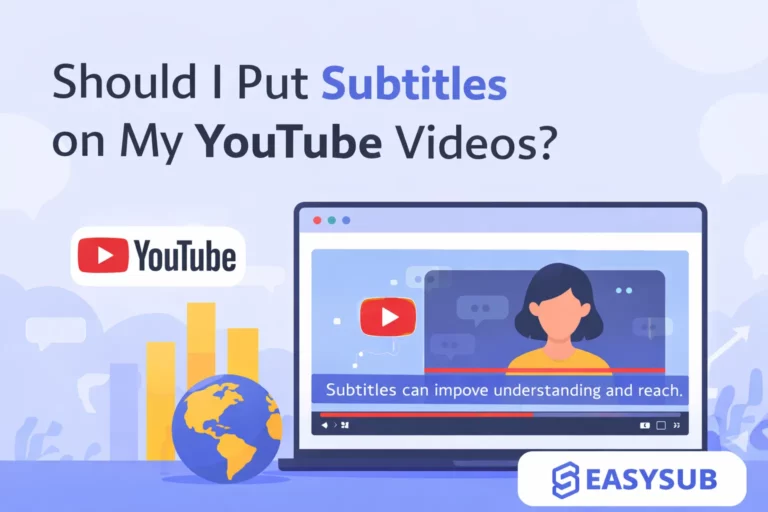Ищете лучшие инструменты искусственного интеллекта? переводить субтитры Точно и эффективно? По мере того, как видеоконтент становится глобальным, перевод субтитров приобретает важное значение для охвата более широкой аудитории и преодоления языковых барьеров. В этом блоге мы рассмотрим лучшие решения на основе искусственного интеллекта, которые помогут вам быстро, доступно и с впечатляющей точностью переводить субтитры на несколько языков.
Оглавление
Почему вам нужен ИИ для перевода субтитлов?
В современном мире стремительного глобального распространения контента видео стало важным средством межъязыковой коммуникации. Будь то презентации корпоративных продуктов, обучающие видеоролики или контент от создателей контента на таких платформах, как YouTube и TikTok, спрос на многоязычные субтитры стремительно растет. Аудитория хочет понимать контент “на своем родном языке”, а бренды стремятся охватить более широкую международную аудиторию.
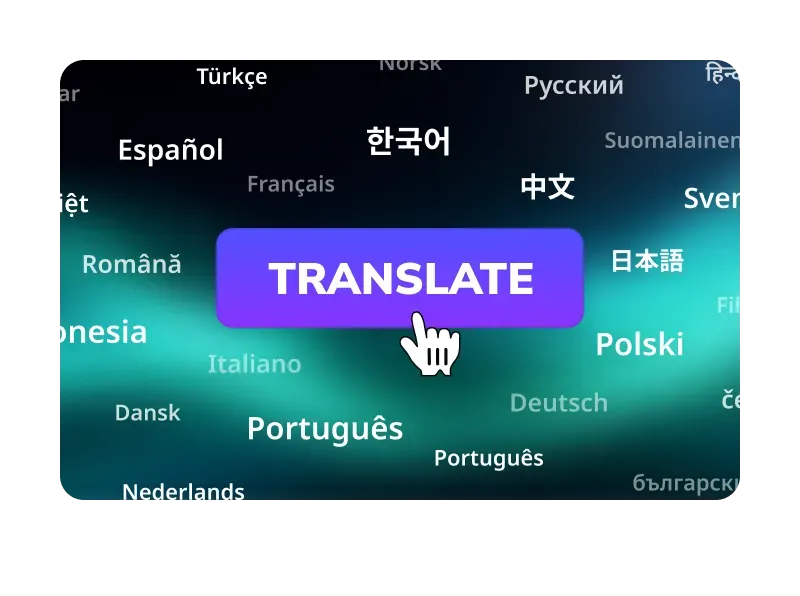
Традиционный перевод субтитров обычно основан на ручной обработке, включающей в себя множество этапов, таких как: транскрипция, перевод, корректура и экспорт в заданный формат.. Этот процесс не только отнимает много времени и сил, но и обходится дорого, что делает его непрактичным для небольших и средних создателей контента или пользователей платформ для коротких видеороликов.
Однако с развитием технологий искусственного интеллекта, в частности распознавания речи (ASR) и нейронного машинного перевода (NMT), инструменты перевода субтитров на основе ИИ заменяют традиционные методы и становятся основным решением. Они позволяют достичь замкнутого цикла обработки информации. Автоматическое создание субтитров + автоматический перевод на несколько языков, значительно повышая эффективность и снижая барьер для языкового обмена.
Использование ИИ для перевода субтитров не только значительно экономит время и средства но также позволяет быстрее распространять видеоконтент по всему миру, что делает его особенно подходящим для:
- Создание многоязычных версий корпоративных рекламных видеороликов.
- Межъязыковое распространение образовательных видеороликов
- Перевод и продвижение коротких видеороликов в социальных сетях одним щелчком мыши.
- Создатели контента на YouTube/Vimeo выходят на зарубежные рынки.
Как работает перевод субтитров с помощью ИИ?
Основной процесс перевода субтитров с помощью ИИ можно условно разделить на три этапа: Распознавание речи (ASR) → автоматическая транскрипция субтитров → машинный перевод (MT) → синхронизация субтитров и вывод в заданном формате. Этот процесс объединяет множество технологий искусственного интеллекта, что значительно повышает эффективность и точность перевода.
① Распознавание речи (ASR: автоматическое распознавание речи)
Система искусственного интеллекта сначала идентифицирует речь в исходном видео и автоматически преобразует её в редактируемый текст. Ключевым моментом на этом этапе является чёткость звука и качество обучения модели распознавания речи. Усовершенствованные модели автоматического распознавания речи могут распознавать различные акценты, скорость речи и интонации, а также различать разных говорящих (диаризация говорящих), обеспечивая точное воспроизведение субтитров.
● Извлечение акустических характеристик
Система сначала обрабатывает аудиосигнал, разделяя непрерывный звуковой сигнал на кадры длительностью в несколько миллисекунд (например, 25 мс на кадр), и извлекает акустические характеристики каждого кадра, такие как мел-частотные кепстральные коэффициенты (MFCC) и мел-фильтровые банки. Эти характеристики помогают системе улавливать тембр, интонацию и скорость речи.

Впоследствии ИИ использует акустические модели (такие как CNN, LSTM или Transformer) используются для сопоставления этих акустических характеристик с речевыми единицами (такими как фонемы или слова), а затем применяются языковые модели. (например, архитектуры RNN или GPT) для понимания контекста и прогнозирования наиболее вероятной последовательности слов. Например:
Аудио: “Здравствуйте, добро пожаловать в инструмент автоматического создания субтитров”.”
Результат транскрипции: Здравствуйте, добро пожаловать в инструмент автоматического создания субтитров.
Современные модели распознавания речи, такие как Whisper (OpenAI), DeepSpeech (Mozilla) и Wav2Vec 2.0 (Meta) все усыновляют сквозные архитектуры глубокого обучения, значительно повышая точность распознавания, особенно в многоязычной, шумной обстановке и при естественной скорости речи.
● Многоязычное распознавание и адаптация к акценту
Усовершенствованные системы автоматического распознавания речи имеют возможности многоязычного распознавания, Это позволяет им точно распознавать такие языки, как китайский, английский, французский и испанский, в одном и том же видео, а также автоматически обнаруживать переключения между языками. Кроме того, они поддерживают адаптация акцента, способный распознавать различные региональные диалекты английского языка (например, американский, британский, индийский) или китайские диалекты.
● Диалогизация докладчиков
Некоторые системы искусственного интеллекта поддерживают функцию распознавания “кто говорит”, то есть, диаризация говорящих. Она может определять смену говорящего на основе характеристик голоса и четко обозначать структуру диалога в субтитрах.
● Фоновый шум и адаптация к окружающей среде
ИИ использует алгоритмы шумоподавления и технологии улучшения речи Эта технология отфильтровывает фоновый шум, такой как ветер, звуки клавиатуры или музыка, обеспечивая четкий речевой сигнал. Она поддерживает высокую точность распознавания даже в сложных условиях, таких как на открытом воздухе, на совещаниях или при записи телефонных разговоров.
② Создание субтитров и выравнивание по временной шкале
В процессе автоматического перевода субтитров с помощью ИИ ключевыми этапами обеспечения качественного просмотра для зрителей являются генерация субтитров и выравнивание по временной шкале. Этот процесс в основном включает следующие основные шаги:
Сегментация субтитровПосле завершения распознавания речи система разделяет непрерывный текст на независимые сегменты субтитров на основе таких характеристик, как скорость речи, изменения интонации и смысловые разрывы предложений. Эти сегменты, как правило, сохраняют смысловую целостность и логику предложений, обеспечивая легкость понимания каждого субтитра.
Отметка времениКаждый субтитр должен быть точно отмечен временем его появления и исчезновения в видео. Искусственный интеллект объединяет исходную звуковую дорожку, распознанный текст и темп речи говорящего для генерации соответствующих данных временной шкалы. Это гарантирует синхронизацию субтитров с видео, избегая задержек или ускорений.
Форматирование выводаНаконец, файл субтитров автоматически форматируется в распространенные форматы субтитров, такие как... .srt (Субтитры SubRip) и .vtt (WebVTT). Эти форматы совместимы с большинством видеоплееров и платформ, что позволяет легко использовать их напрямую или импортировать в инструменты редактирования.
Оптимизация ритма и читабельностиВысококачественные инструменты для создания субтитров на основе искусственного интеллекта также оптимизируют длину, количество символов и продолжительность отображения каждой строки субтитров, чтобы гарантировать, что ритм отображения не будет слишком быстрым, чтобы не вызывать затруднений при чтении, и не слишком медленным, чтобы не нарушать непрерывность просмотра.
③ Машинный перевод (МТ)
После генерации текста субтитров система искусственного интеллекта использует передовые технологии машинного перевода для перевода субтитров на несколько языков. В основе этого процесса лежит архитектура нейронной сети, в частности. Нейронный машинный перевод (НМТ) на основе модели трансформера. Эта модель, обученная с помощью глубокого обучения на больших объемах двуязычных или многоязычных корпусов, способна понимать контекстную логику целых предложений, а не просто заменять слова по одному, тем самым достигая... более естественный, беглый и семантически точный результат перевода.
④ Экспорт и синхронизация многоязычных субтитров
После завершения машинного перевода система искусственного интеллекта переходит к этапу экспорта и синхронизации субтитров, что имеет решающее значение для обеспечения точного отображения многоязычных субтитров и удобства пользователя. Конкретные этапы процесса и технические детали описаны ниже:
Создание файлов субтитров в различных форматах
Различные видеоплатформы и плееры поддерживают разные форматы субтитров. Системы искусственного интеллекта обычно поддерживают экспорт нескольких распространенных форматов, таких как:
- .srt (SubRip Subtitle)Наиболее универсальный и легко совместимый формат субтитров, широко используемый на таких платформах, как YouTube и Vimeo;
- .vtt (текстовые дорожки для веб-видео)Разработан специально для веб-видео, поддерживает больше элементов управления стилем и подходит для HTML5-плееров;
- .ass (Advanced SubStation Alpha)Поддерживает расширенные возможности форматирования и эффекты, часто используемые для субтитров к аниме и фильмам;
- Другие форматы, такие как .ttml, .dfxp Также может генерироваться по мере необходимости.
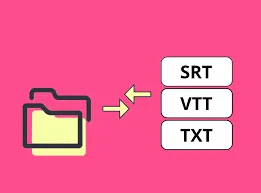
Экспорт многоязычных версий одним щелчком мыши
Пользователи могут экспортировать файлы субтитров для нескольких целевых языков одновременно, что удобно для создателей видео, позволяя им загружать контент на каналы в разных языковых регионах и значительно упрощая процесс публикации многоязычных видеороликов.
Поддержка встроенных и отдельных субтитров
Система поддерживает генерацию мягкие субтитры (дополнительные внешние субтитлы) и жесткие субтитлы (встроенные непосредственно в видеокадр), что позволяет учитывать потребности различных платформ и клиентов. Например, некоторые социальные сети рекомендуют использовать мягкие субтитры, чтобы пользователи могли свободно переключать языки.
Контроль качества и тестирование совместимости
Высококачественные инструменты для создания субтитров на основе искусственного интеллекта также выполняют автоматическую проверку, чтобы гарантировать соответствие экспортируемых файлов субтитров стандартам формата, отсутствие наложений временной шкалы, искаженных символов или неполного содержимого, а также совместимость с распространенными проигрывателями, тем самым улучшая качество просмотра для конечных пользователей.
Лучшие инструменты искусственного интеллекта для перевода субтитров в 2025 году
1. Google Translate + Инструмент для создания субтитров на YouTube
Функции
- Использует мощные возможности машинного перевода Google Translate, поддерживая перевод более чем на 100 языков.
- Сочетает функцию автоматической генерации субтитров YouTube с функцией перевода, позволяя авторам контента быстро создавать многоязычные субтитры.
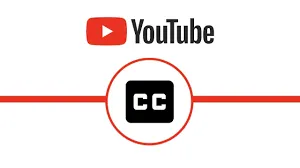
Пользовательский опыт
- Подходит для обычных пользователей и начинающих создателей контента, отличается простым управлением и является совершенно бесплатным.
- Результаты перевода получаются быстро, но иногда могут быть слишком буквальными, с недостаточной адаптацией к разговорной речи.
- Функции редактирования субтитров на YouTube ограничены и не поддерживают сложное форматирование.
Преимущества и недостатки
- Преимущества: Бесплатно, широкий языковой охват и высокая удобность использования.
- Недостатки: Точность перевода ограничена, особенно при работе с профессиональной терминологией или разговорными выражениями; гибкость форматирования субтитров невелика.
2. DeepL + профессиональный редактор субтитров (например, Aegisub)
Функции
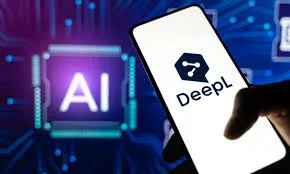
- DeepL использует передовую в отрасли технологию нейронных сетей для перевода, обеспечивая естественный и плавный перевод, особенно для европейских языков.
- В сочетании с профессиональным редактором субтитров это позволяет точно настраивать временную шкалу субтитров и форматировать их.
Пользовательский опыт
- Идеально подходит для профессиональных создателей субтитров и команд переводчиков, обеспечивая превосходное качество перевода.
- Требуется высокий уровень технических навыков, а ручная корректура и редактирование занимают значительное время.
- Пакетная обработка данных на нескольких языках — трудоемкий процесс, которому не хватает автоматизации.
Преимущества и недостатки
- Преимущества: Высококачественный перевод, поддержка профессиональной настройки и оптимизации терминологии.
- Недостатки: высокий порог использования, сложный рабочий процесс и более высокие затраты.
3. Easysub — универсальный инструмент для автоматического перевода субтитров с помощью ИИ.
Функции
- Интегрирует передовые технологии распознавания речи, машинного перевода и генерации субтитров, позволяя осуществлять автоматическую транскрипцию одним щелчком мыши, многоязычный перевод и экспорт в различные форматы.
- Поддерживает множество видеоформатов и экспортирует распространенные форматы субтитров (.srt, .vtt и т. д.) для кроссплатформенного использования.
- Предоставляет функции управления терминологией и оптимизации разговорного стиля для адаптации к различным областям знаний и культурным потребностям.

Пользовательский опыт
- Удобный интерфейс, подходящий для создателей контента, предприятий и образовательных учреждений.
- Высокая степень автоматизации значительно экономит время и трудозатраты.
- Поддерживает многоязычную параллельную обработку и пакетную обработку видео.
Преимущества и недостатки
- Преимущества: Простота использования, высокая эффективность, точный перевод и широкая интеграция функций.
- Недостатки: Расширенные функции персонализации могут быть платными, а некоторые узкоспециализированные поля по-прежнему требуют подтверждения от пользователя.
Таблица: Сравнение основных инструментов перевода субтитров с использованием ИИ в 2025 году.
| Название инструмента | Основные характеристики | Пользовательский опыт | Преимущества | Недостатки | Целевая аудитория |
|---|---|---|---|---|---|
| Google Перевод + YouTube | Машинный перевод + автоматическая генерация субтитров | Простой и удобный в использовании, бесплатный. | Широкий языковой охват, высокая скорость. | Переводы, как правило, дословные, с ограниченными возможностями редактирования субтитров. | Начинающие создатели контента, обычные пользователи |
| DeepL + редактор субтитров (Aegisub и др.) | Высококачественный перевод с использованием нейронных сетей + точное редактирование субтитров | Высокое качество перевода, сложная операция | Естественный и плавный перевод, поддержка профессиональной персонализации. | Сложный процесс, требующий длительного обучения. | Профессиональные специалисты по созданию субтитров, команды переводчиков. |
| Изисаб | Автоматическая транскрипция одним щелчком мыши, многоязычный перевод и экспорт. | Удобный интерфейс, высокая степень автоматизации. | Высокая степень интеграции, высокая эффективность, поддержка пакетной обработки. | Расширенные функции платные, для некоторых профессиональных областей требуется ручная проверка. | Производители корпоративного контента, образовательные учреждения, создатели трансграничного видеоконтента |
Почему Easysub — лучший выбор для перевода субтитров?
В условиях растущего разнообразия и интернационализации глобального видеоконтента выбор эффективного, точного и удобного инструмента для перевода субтитров становится все более важным. Easysub выделяется как лучший выбор для многих создателей контента и компаний благодаря своим передовым технологиям и удобному дизайну.
Поддержка многоязычного автоматического перевода:
Easysub оснащен передовым нейронным механизмом машинного перевода, который может автоматически переводить оригинальные субтитлы видео на несколько целевых языков, охватывая как основные международные языки, так и региональные языки, чтобы удовлетворить потребности просмотра глобальной аудитории. Такая комплексная многоязычная поддержка значительно упрощает процесс создания интернационализированного контента.
Автоматизированный процесс создания субтитров и перевода с использованием искусственного интеллекта:
В отличие от традиционных пошаговых процессов, Easysub органично интегрирует распознавание речи (ASR), генерацию субтитров, синхронизацию по временной шкале и машинный перевод, значительно повышая эффективность. Пользователям достаточно просто загрузить видео, и система автоматически выполнит весь процесс, устраняя необходимость в утомительном ручном редактировании и преобразовании формата.
Доступны различные форматы экспорта субтитров:
Платформа поддерживает экспорт распространенных форматов субтитров, таких как .srt и .vtt, а также может создавать видео с жесткими субтитрами в формате MP4 для обеспечения совместимости с различными платформами и устройствами. Независимо от того, используется ли она для YouTube, корпоративного обучения или публикации в социальных сетях, она легко адаптируется к различным потребностям.
Не требует установки, можно сразу использовать онлайн, что значительно снижает порог использования:
Easysub работает полностью в облаке, не требуя загрузки или установки программного обеспечения от пользователей и поддерживает многотерминальный доступ и работу. Независимо от того, является ли это индивидуальным проектом или большой командой, перевод субтитров можно выполнять в любое время и в любом месте через браузер, что значительно повышает удобство и гибкость.
Шаг 1: Зарегистрируйте бесплатный аккаунт.
-1024x500.png)
Сначала нажмите кнопку “Регистрация” на главной странице, чтобы перейти на страницу регистрации аккаунта. Вы можете зарегистрироваться, введя свой адрес электронной почты и пароль, или войти через свой аккаунт Google, чтобы быстро получить бесплатный аккаунт, который позволит вам использовать все функции Easysub.
Шаг 2: Загрузите видео- или аудиофайлы
.png)
После входа в систему нажмите кнопку “Новый проект” и выберите... видео или аудио В появившемся окне загрузки вы можете расшифровать и перевести нужные файлы. Вы можете выбрать файлы непосредственно с локального компьютера или перетащить их в область загрузки. Для более быстрой обработки видео вы также можете напрямую вставить ссылку на видео с YouTube, и система автоматически получит доступ к видеоконтенту.
Шаг 3: Автоматическое создание субтитров и многоязычных переводов.
.png)
После загрузки нажмите кнопку “Добавить субтитры”, чтобы перейти в интерфейс настройки автоматической генерации субтитров. Здесь вам нужно выбрать исходный язык видео и целевой язык, на который вы хотите перевести видео. После подтверждения система запустит процесс распознавания речи с помощью ИИ и машинного перевода, автоматически генерируя двуязычные субтитры с временными метками, что обычно занимает несколько минут.
Шаг 4: Перейдите на страницу с подробной информацией для проверки и редактирования субтитров.
-1024x351.png)
После создания субтитров нажмите кнопку “Редактировать”, чтобы открыть страницу со списком субтитров. Выберите созданный файл субтитров, чтобы перейти к подробному интерфейсу редактирования. Здесь вы можете проверить и скорректировать временные шкалы автоматически распознанного и переведенного текста, чтобы убедиться в точности субтитров и плавности просмотра.
Шаг 5: Разнообразное редактирование и экспорт субтитров и видео.
-1024x598.png)
После входа в интерфейс редактирования, помимо изменения текста, вы также можете настроить стиль шрифта, цвет и положение субтитров, чтобы лучше интегрировать их с видеоматериалом. Кроме того, система поддерживает настройку цвета фона, параметров разрешения и персонализированные операции, такие как добавление водяных знаков и заголовка к видеоматериалу. После редактирования вы можете экспортировать субтитры в различные распространенные форматы (например, .srt, .vtt) одним щелчком мыши или экспортировать видеофайлы с встроенными субтитрами для удобной загрузки на различные платформы. Вы также можете напрямую загружать файлы субтитров или видео для удовлетворения различных потребностей.
Часто задаваемые вопросы
1. Какие языки поддерживает Easysub?
Easysub поддерживает распознавание речи и перевод субтитров для более чем 100 основных мировых языков и диалектов, включая английский, китайский, испанский, французский, немецкий., японский, Корейский, русский, арабский и другие языки, удовлетворяющие разнообразные потребности различных регионов и отраслей.
2. Поддерживает ли Easysub вывод встроенных субтитров?
Да, Easysub не только поддерживает экспорт распространенных форматов субтитров (таких как .srt, .vtt), но и позволяет встраивать субтитры непосредственно в видеофайлы для создания видеофайлов в формате встроенных субтитров (Burn-in), что удобно для загрузки на платформы воспроизведения, которые не поддерживают субтитры.
3. Каков показатель точности перевода? Возможна ли проверка перевода человеком?
Easysub использует передовые модели перевода на основе нейронных сетей для обеспечения высокой точности и плавности перевода субтитров. Однако для специализированной терминологии или конкретных контекстов мы рекомендуем пользователям проверять субтитры вручную после их создания. Easysub предоставляет удобный инструмент. онлайн-редактирование субтитров эта функция позволяет пользователям вносить подробные изменения в переведенный контент.
4. Поддерживает ли Easysub пакетную обработку нескольких видеофайлов?
Да. Easysub предлагает функцию пакетной загрузки и перевода, позволяя пользователям импортировать несколько видео одновременно. Система автоматически ставит их в очередь на обработку, значительно повышая эффективность. Это идеально подходит для компаний и создателей контента, которым необходимо массово создавать многоязычные субтитры.
5. Требуется ли установка программного обеспечения для использования Easysub?
Нет. Easysub полностью основан на облачных технологиях. Пользователи могут получить доступ к сервису через веб-браузер без необходимости загрузки или установки какого-либо клиентского программного обеспечения, что обеспечивает гибкий доступ и работу на различных устройствах и терминалах.
Заключение: Будущее перевода субтитров с помощью ИИ
Технологии искусственного интеллекта не только значительно повышают скорость генерации и перевода субтитров, но и постоянно оптимизируют точность перевода и контекстную адаптивность за счет глубокого обучения и обработки естественного языка. В будущем перевод субтитров с помощью ИИ станет более интеллектуальным, будет поддерживать больше языков и диалектов, улучшит обработку профессиональной терминологии и обеспечит более естественное и беглое многоязычное выражение.
Компания Easysub, являясь лидером в отрасли инструмента автоматической генерации видео с использованием искусственного интеллекта, стремится к технологическим инновациям и улучшению пользовательского опыта. Благодаря постоянной интеграции новейших моделей перевода на основе нейронных сетей и оптимизации алгоритмов распознавания речи, Easysub постоянно повышает точность и эффективность перевода субтитров. Кроме того, платформа уделяет приоритетное внимание обратной связи от пользователей и дизайну взаимодействия, предлагая удобное онлайн-редактирование и экспорт в различные форматы, что позволяет пользователям гибко настраивать контент субтитров. В будущем Easysub продолжит лидировать в разработке технологий перевода субтитров с использованием искусственного интеллекта, предоставляя создателям видеоконтента и компаниям по всему миру более профессиональные, эффективные и интеллектуальные решения для создания субтитров.
Попробуйте Easysub прямо сейчас!
Присоединяйтесь к Easysub сегодня и оцените новый уровень интеллектуального перевода субтитров! Просто зарегистрируйтесь и получите бесплатный аккаунт. Загружайте свои видео без труда и мгновенно создавайте многоязычные субтитры. Независимо от того, являетесь ли вы индивидуальным создателем контента, бизнес-командой или образовательным учреждением, Easysub поможет вам эффективно создавать субтитры, экономя ваше время и средства. Действуйте прямо сейчас, попробуйте бесплатно и оцените удобство и профессионализм искусственного интеллекта. Пусть ваш видеоконтент без труда преодолевает языковые барьеры и достигает глобальной аудитории!

Позвольте ИИ расширить возможности вашего контента всего за несколько минут!
👉 Нажмите здесь, чтобы получить бесплатную пробную версию: easyssub.com
Спасибо за чтение этого блога. Не стесняйтесь обращаться к нам, если у вас есть дополнительные вопросы или вам нужны индивидуальные решения!
